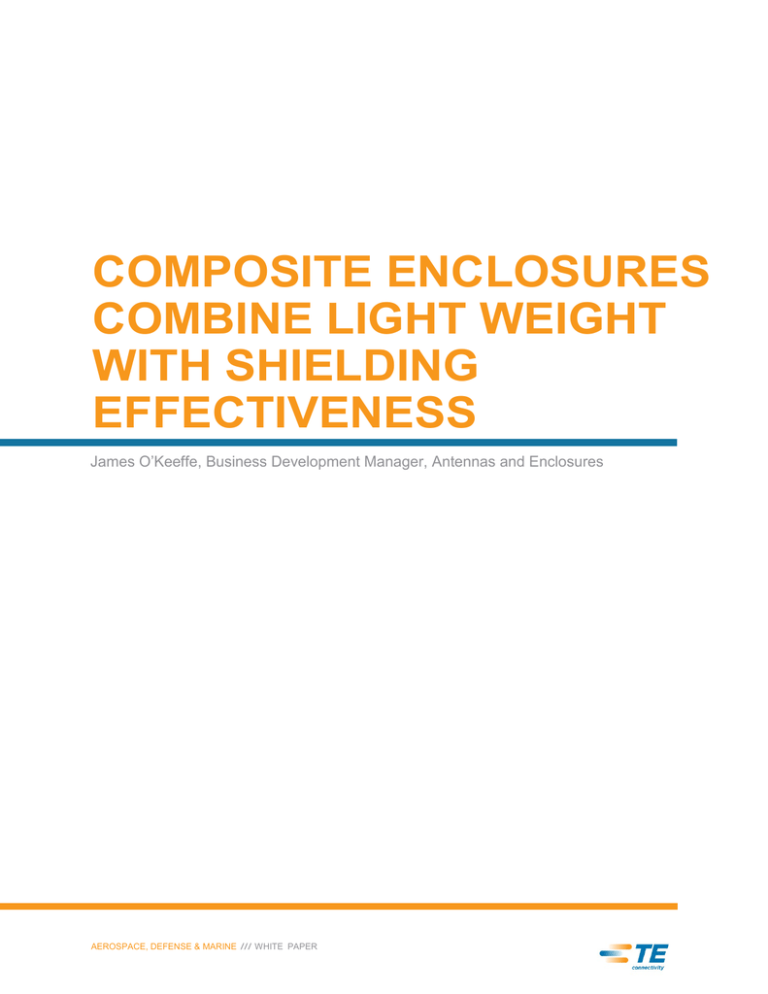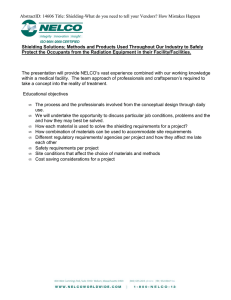
COMPOSITE ENCLOSURES
COMBINE LIGHT WEIGHT
WITH SHIELDING
EFFECTIVENESS
James O’Keeffe, Business Development Manager, Antennas and Enclosures
AEROSPACE, DEFENSE & MARINE /// WHITE PAPER
-
COMPOSITE ENCLOSURES
COMBINE LIGHT WEIGHT
WITH SHIELDING
EFFECTIVENESS
James O’Keeffe, Business Development Manager, Antennas and Enclosures
Composites are a game-changing technology in the aerospace and defense markets and increasingly in the automotive,
consumer and medical industries. Reinforced polymer composites aim to offer the best of both worlds, replicating the
strength of metals, while offering the corrosion resistance, weight and cost of engineering polymers. While composites
have been embraced for structural applications, their proliferation into electrical and avionics systems has been slower.
Here we discuss how advances in high-volume composite manufacturing for enclosures and EMI shields are enabling
companies such as TE Connectivity (TE) to offer significant electrical system advantages.
Figure 1.Composite enclosures combine weight reduction with mechanical strength and shielding effectiveness (source:
TE Connectivity).
Molding complex composites instead of matching metals
The initial attraction of composite enclosures is weight savings—a carbon-filled PPS composite enclosure can be 40
percent lighter than an aluminum one. In aircraft and satellites, saving a pound here and a pound there adds up to
significant overall weight reduction, which translates into performance increases. A UAV can fly longer; a fighter jet can
achieve better fuel economy and carry more armaments. In a satellite, every pound of reduced weight can save
thousands of dollars in launch costs.
Composites are already used in aerospace applications, particularly for larger structural elements. These composites
typically are thermoset materials. In a thermoset composite, glass or carbon fibers are encapsulated in an epoxy resin
matrix. An autoclave oven cures the parts with a combination of heat and pressure. The drawback is that the hand layup
and curing processes are labor and capital intensive, and throughput is generally limited to a single batch of parts per
shift. What’s more, such hand layup parts lacked the tolerances required for electrical components including enclosures,
connectors, and other smaller items requiring precise dimensions. Equally lacking are capabilities for high-volume, costeffective manufacturing.
AEROSPACE, DEFENSE & MARINE /// WHITE PAPER
PAGE 2
Themoplastic Composites
Fortunately, a new generation of carbon fiber composites is addressing the need for cost-effective, high-throughput
parts. Beyond uses in automotive and consumer electronics, this new generation of composites is targeted at replacing
metals in enclosures and EMI shields. Key features are the use of high-volume molding techniques and coatings to
provide EMI shielding equivalent to metals. TE has been actively researching composite materials and improved
methods of producing them in practical shapes.
A typical thermoplastic composite begins with a high-performance engineered plastic to which fillers are added to
enhance characteristics. For electronic enclosures, the plastic is likely to be a high-temperature moldable thermoplastic,
such as grades of PPS, PEI, PEEK, or LCP. The actual thermoplastic is usually determined by a combination of
required operating temperature and the fluid exposure likely to be seen. While glass fibers have been the most
commonly used filler materials for adding structural strength, carbon fibers or other conductive fillers are required to
produce materials with good EMI performance. Metal fillers are a possibility but are sometimes discounted because of
the weight they add to the material.
Carbon can be added in many forms: as carbon nanotubes (CNTs), graphene platelets, short or long carbon fibers,
carbon microspheres, and simple carbon particles. Figure 2 summarizes the benefits of each. These filler materials
make the plastic conductive to provide EMI shielding. The bulk resistivity of CNT-filled plastic can be less than 10 Ω-cm
@ 5 to 10 percent filler volume and under 1 Ω-cm @ 50% percent volume. Additional conductivity can sometimes be
obtained by metal coating the carbon-based fillers.
The type of carbon selected will have significant effect on the strength of the resulting composite material. Long carbon
fibers, for example, can be used to increase the strength and hardness of the material to equal or even surpass metal.
Form
Features/Benefits
Carbon Nanotubes
Highest aspect ratio (>10,000, can be much larger)
Costs range from very high to moderate depending upon CNT type
Excellent conductivity, but no mechanical reinforcement
Graphene Platelets
2D structure
Higher cost
Good conductivity, but no mechanical reinforcement
Short Carbon Fibers
Low aspect ratio (<300)
Good balance of cost vs. performance
Flexible to a variety of molding processes
Long Carbon Fibers
High aspect ratio (>1000)
Incapable of injection molding
Higher mechanical strength, especially impact strength
Carbon Microspheres
Low-density hollow sphere (D50 ~ 10 µm)
Fragile upon high shear
Achieve 15+ percent weight saving, while maintaining conductivity
Carbon Particles
Cost-effective ingredient
Moderate conductivity, good for ESD protection
Figure 2. Different filler options meet different needs (source: TE Connectivity).
AEROSPACE, DEFENSE & MARINE /// WHITE PAPER
PAGE 3
EMI Shielding
Since any electronic system must work within its electromagnetic environment, control of EMI is critical. Shielding is a
critical part of EMI control. EMI protection is a two-way street. A system must control its own generation of EMI so that it
does not interfere with other systems. At the same time, the system must be protected from interference from outside
sources. Shielding works both to contain internally generated noise and to protect against outside interference.
Metal enclosures offer excellent shielding. Noncomposite plastic enclosures are transparent to EMI. Composite
enclosures can be designed with varying levels of shielding effectiveness. Users must not only determine the degree of
shielding required, but also the frequencies that must be dealt with. Shielding effectiveness varies with frequency.
A metal enclosure provides EMI protection mainly by reflecting energy. This is an advantage when the unwanted energy
comes from outside the enclosure. When EMI is radiated by the electronics within the enclosure, energy can be
reflected back into the electronics instead of being eliminated. Composite enclosures, on the other hand, provide a
combination of reflection and absorption.
Carbon-fiber fillers exhibit significantly less conductivity than metal. Similar to metal, these materials will conduct EMI.
However, their less efficient conductivity means EMI is absorbed and dissipated as heat rather than being conducted to
ground.
Enclosures can achieve better shielding effectiveness by either making the fillers more conductive (i.e., more metal-like)
or by adding a layer of metal to the enclosure.
Conductive fillers: Carbon fiber or metal-plated fibers can offer modest shielding of 20 to 40 dB over a wide frequency
range. Shielding effectiveness can be increased by using high loading of conductive nanomaterials.
For higher levels of shielding, a metal layer is added to the material. Approaches include:
•
Foil bonded to the composite
•
Copper mesh injection molded onto the composite
•
Electroplated with a thin layer of copper over a nickel underplating
Foils are less attractive for enclosures and other precision shapes because of the difficulty of conforming the foil to the
shape.
Copper mesh has been traditionally used on airframe structures for EMI and lightning protection. A copper mesh can be
injection molded onto a composite enclosure. This technique offers excellent EMI shielding of -80 dB up to 25 GHz. A
challenge with this technique is getting complete coverage of complex shapes.
Electroplating. A 10 to 25 micron stack of metal layers are deposited on the composite part. A strong bond is formed by
mechanically or chemically preparing the underlying composite surface. The stack typically includes a high conductivity
metal such as copper and a passivating layer such as nickel. A standard 15 micron plating on composites offer EMI
protection in excess of -70 dB up to 25 GHz.
Figure 3 shows the shielding effectiveness of carbon-fiber-filled polyphenylene sulfide composites with 10-15 microns of
nickel/copper plating, using the IEEE 299 method. The plated composite offers the same shielding effectiveness as
aluminum (>80 dB up to 22 GHz). From a shielding standpoint, composites are clearly a viable alternative to aluminum,
capable of providing shielding effectiveness well beyond that required for most applications. If you factor in the strength
and light weight of composites, aluminum loses much of its luster. Composites, rich in variety of formulations, can be
tailored to the needs of specific applications.
AEROSPACE, DEFENSE & MARINE /// WHITE PAPER
PAGE 4
Figure 3. Carbon-filled composites composites plated with 5 or 10 microns of copper over a 5-micron nickel underplating
(source: TE Connectivity).
Conclusion
In specifying a composite enclosure, work closely with your supplier to carefully match your application needs with the
composite formulation. Often this formulation will involve a combination of filler types providing a synergistic solution.
There is no single best solution, but it is possible to find the best balance of characteristics (strength, EMI performance,
thermal management, internal features such as circuit traces and standoffs, and so forth) to provide enhanced
performance at lower costs.
Author’s Bio
James O’Keeffe, PhD, PE, is the Business Development Manager-Antennas and Enclosures for TE
Connectivity, Global Aerospace, Defense & Marine. He has more than 13 years’ experience working
on embedded electronics, integrated system testing, enclosures, composites and antennas. You can
connect with Jim at www.DesignSmarterFaster.com.
AEROSPACE, DEFENSE & MARINE /// WHITE PAPER
PAGE 5
te.com
MULTIGIG RT and MULTI-BEAM XLE are trademarks of the TE Connectivity Ltd. family of companies.
Legal. TE Connectivity, TE connectivity (logo) and Tyco Electronics are trademarks of the TE Connectivity Ltd. family of companies and its licensors.
While TE Connectivity has made every reasonable effort to ensure the accuracy of the information in this document, TE Connectivity does not guarantee that it is error-free, nor
does TE Connectivity make any other representation, warranty or guarantee that the information is accurate, correct, reliable or current. TE Connectivity reserves the right to make
any adjustments to the information contained herein at any time without notice. TE Connectivity expressly disclaims all implied warranties regarding the information contained
herein, including, but not limited to, any implied warranties of merchantability or fitness for a particular purpose. The dimensions in this document are for reference purposes only
and are subject to change without notice. Specifications are subject to change without notice. Consult TE Connectivity for the latest dimensions and design specifications.
Tyco Electronics Corporation, a TE Connectivity Ltd. Company. All Rights Reserved.9-1773465-3 6/12 Original © 2012
AEROSPACE, DEFENSE & MARINE /// WHITE PAPER
PAGE 6


